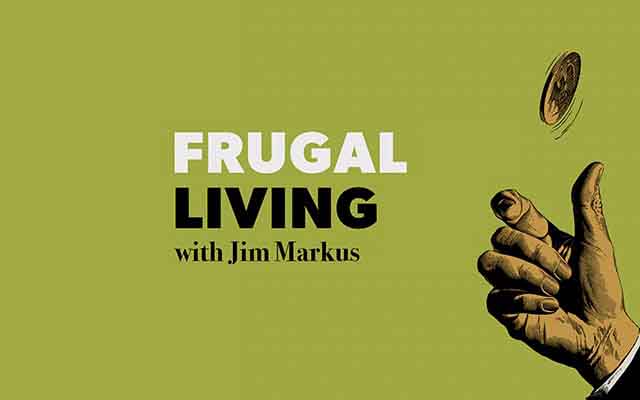Is It Safe to Invest In Crypto?
In this week’s episode, Jim speaks with Andy Wang about cryptocurrencies and whether or not they’re a good investment. Listen to the latest episode of Frugal Living on Apple Podcasts, Spotify, Google Podcasts, Anchor.fm, iHeartRadio, or anywhere you go to find podcasts.
Andy Wang, the host of Inspired Money, talked with us about how to invest during uncertain times. We spoke about inflation and rising interest rates, and we wanted to dive even deeper into another popular topic for investors. Is crypto worth consideration?
Read a Transcript From This Episode
Jim (01:08):
I see crypto and I see, I think what a lot of people see… Whether you want it or not, crypto’s not going anywhere. Like, the blockchain is a technology that we haven’t plumbed it to its steps. We haven’t mined everything we can out of it yet. There’s a lot we can still do that people are getting excited about. I talked to Andy Wang, who’s, like, a fiduciary financial advisor. And he has an episode of the podcast where, like, I just talked to him about, you know, financial advice and, like, inflation and all the fun stuff that’s happening this year. But I also asked him about crypto. Here’s our conversation. <music> You’re going to have a more informed opinion on this than most people that freely talk about this. What do you think about crypto? People talk about it like it’s the modern gold. You know, it’s like, “It’s a hedge.” But it’s crypto. What are your thoughts?
Andy (02:02):
I think that the challenge with calling Bitcoin specifically because Bitcoin being, like, the biggest market cap cryptocurrency and probably the oldest, it’s often called digital gold. I think the problem is that when you look at the price movement, it’s not really correlated to gold. Conceptually that’s the role that they wanted to serve. But I think that it’s been more closely correlated to other risk assets. We’ve seen that recently. I mean last year, Bitcoin going from 60,000 down to, I don’t know, below 40, right? Maybe close to 30,000. Like, it got cut in half. And that was not in a bear market.
So you’re dealing with something that is extremely volatile. And because of that, as a financial advisor and being a fiduciary, I can’t recommend that people own too much of. I mean, I don’t think it’s prudent to own an asset class that is that volatile, that can get cut in half really for not a really big reason. On the other hand, looking at cryptocurrency, looking at blockchain, I think that there’s something there worth paying attention to. And sometimes I use the analogy of looking at 1999, year 2000 when everyone was so excited about the internet. And those were the days where business plans didn’t matter. Everyone talked about, “It’s a land grab! It’s about eyeballs!” And companies can figure out how to make a profit later. Conceptually, that was kind of true. It just took, like, 15 years for companies to actually realize–like, Google and Facebook to emerge–that had real business models and could be profitable.
In the early days, in the wild, wild west days, you just don’t know which companies are gonna no longer exist. It’s hard to tell who the winners will be because it’s early. I have the sense that crypto, Web3, right? Metaverse, all of that… There’s a possibility that it won’t take 15 years. Just things seem to be happening much quicker. Whether it’s innovation or just information spreading because of the internet. Like, cycles just happen quicker. So what if in, like, three to five years, right now is the early days of something that is transformative to products or services that we’re enjoying or the way that we live? You know, there’s a lot of talk about will there be a digital dollar. Like, will governments hop onto the benefits of having a, a digital currency? And you start reading about that stuff. And it’s fascinating because even during this pandemic when there were stimulus checks going out, if there had been a digital currency and every citizen had a digital wallet, the government could just issue your digital currency. Just the administrative benefits would be huge. And, like, the ease of them putting a stimulus check in every citizen’s wallet, I think that that’s really cool.
Going a step beyond, they could actually put certain criteria or conditions saying that, “All right, we’re gonna issue you this digital dollar. You can only use it for food.” Something like that built into some kind of contract. I think that the implications are really interesting. We don’t quite know what it’s gonna look like, you know, 10 years from now or 20 years from now. But I think that there’s something there. And even blockchain technology for our bank to better verify our identification and to have, like, a better paper trail if it’s stored in the blockchain. I think that there’re really, really interesting things to look for especially as investors. It’s like we’re the opportunities for growth. And I think that there will be opportunities.
Jim (06:03):
I like the optimism. I think you get very different responses to the question, “Is crypto safe?” The answer’s probably no. Is crypto a worthwhile investment? Maybe. It sounds like what you’re is there’s something there. Blockchain has promise. Blockchain currencies have been popular. We’ve seen some growth. We’ve also seen some incredible declines very quickly. But I like the idea of, you know, take a measured approach. This isn’t the whole of your portfolio and it shouldn’t be the whole of your portfolio. And I think that’s what you’re saying.
Andy (06:37):
I think that if you’re a believer in blockchain and crypto, I think it’s worth owning some. I think that you really have to take a look at what percentage of your overall investable portfolio you want to have in it because of the volatility. Bitcoin Market Journal–I think that’s what it’s called–they have, like, a Believers Portfolio. And of course you have the benefit of hindsight, but what they’re recommending is that you look at cryptocurrency like an asset class. And you just allocate, like, 1 to 3% to it. If you’re really bold, it’s, like, up to 10%. But you’re earmarking a portion of your investments that you’re saying, “Okay, I’m willing to lose 10%” if you’re gonna go to, like, the really bold side. But with the benefit of hindsight, you know, you look at the numbers because Bitcoin has appreciated so much since… I don’t know what period they’re looking at. But say they’re looking at, like, 2006, 2007. You know, just having, like, that 1 to 3% allocation, it was like the performance juice to a conservatively positioned, like, 60, 40 stock-to-bond portfolio. You just added a little bit of crypto in there and you didn’t look at it. You completely ignored the short-term volatility. There are times when it gets cut in half. But if you just left it there and didn’t look, over time it did help your performance.
I think that that’s an interesting way to look at it. And the way that they’re trying to paint it is that, “All right, you’re still a value investor. You’re just willing to have, like, a small portion.” And you know, it’s high risk. It might go to zero and be worthless, but you’re like, “Okay, just one to 3%. I’m willing to lose that.” And if it works out, it could be like the lightning in your portfolio. But I guess similarly, I mean, you could have, like, a conservative investment portfolio, but you just earmark, like, a small portion for higher, more speculative stocks in companies, because you’re trying to control your risk. You know that there’s this relationship: risk to reward. So you wanna control how much you’re gonna do. You’re not gonna do too much. So that way it’s still prudent, but you know, I shouldn’t say gamble, but essentially that’s what it is. Right? It’s like this very small portion of your portfolio. And you’re saying, “All right, I’m almost willing to gamble this part.”
Jim (08:58):
Sure. Yeah, you’re hoping it doesn’t drop to zero. You wouldn’t have invested if you thought it was going to. But at the same time, you’re not certain of growth. I mean, crypto is so full of so many scams and there’s so little regulation right now.
Andy (09:11):
Well, wild, wild west, I think. That’s where it is right now. And you know, we do see more regulation happening. Even the U.S. Securities and Exchange Commission, they’re reviewing crypto and trying to come up with regulation. Different countries are coming up with regulations. I know that some of the Arab countries have gotten some attention recently issuing some, like, policies on crypto for their citizens. And you know, the regulation, I would say, goes against the core principles of crypto, like, when it was created. But you know, one can argue that that regulation is showing that there’s legitimacy there. Or, it’s kind of verifying the fact that if governments are paying attention and starting to regulate, it’s maturing. And you know, may develop into something that becomes more normal and is less fringe.
Jim (10:06):
I mean, it certainly caught the attention of the biggest banks. And when we started seeing, you know, JP Morgan investing in Bitcoin, that doesn’t seem so abnormal now. But when it happened, that’s newsworthy.
Andy (10:19):
Yeah. And Jamie Dimon still says that he doesn’t really advocate owning Bitcoin or crypto. But he knows that his clients want it. You know? So it’s a little bit of an about face, right?
Jim (10:29):
It’s certainly hard to see how that forms. But I know that the conversation we have about crypto is gonna be completely different in five years. This year, in the past 12 months, we’ve seen the conversation around NFTs, you know, explode. Now it’s like talking about modern art. You know, it’s talking about, like, having a piece of art in your house, in the best case. Or it’s like someone selling you a receipt to something they don’t own in the worst case. It’s just hard to have those conversations with a frugal mindset and think NFTs are worth exploring.
Andy (11:01):
Yeah. It’s a tricky one. It’s one that–I don’t know. I mean, when people tell me about CryptoKittys, like, collecting a digital cat. I just can’t wrap my head around it because I didn’t collect Beanie Babies either. In my view, I’m like, “Well now you’ve got a digital Beanie Baby that doesn’t even exist. How does that have value?” But on the other hand, it’s all about supply and demand, right? And I think in any collectible, you don’t have to explain why there’s demand and why people wanna collect it. If that demand is there, the price can go up. And in the view of the collectors, it’s worth something. And that price can increase or decrease. Who am I to say that you should or shouldn’t, or that it exists or doesn’t exist.
I think for people who grew up collecting sports cards or other sports memorabilia, at least it makes sense. At least there’s, like, a little bit of a easier transition to what it is and maybe why there’s value. Again, I didn’t collect sports cards either. But I’ve talked to guys who have some background in art and design and they say, “All right, well, I’m gonna collect some artwork that I appreciate. And I understand that if it goes to zero in value, I’ll at least appreciate the artwork.” And I guess in that sense, it’s no different from collecting actual artwork. Except now you’ve got something on the blockchain and that can at least verify authenticity and scarcity. So maybe there is some pluses there. But these are guys who are trading NFTs, kind of, just for fun. And you know, last year was a good year. So pretty profitable for some. But yeah, you have to be careful. There are a lot of scams and you’ll continue to hear those stories unfortunately.
Meanwhile, the expectation is that China may issue its central bank digital currency sometime this year or next. So I think, you know, with, with great curiosity, I’ll be watching because if China does it as a large economy, you know, the United States will probably follow. We’ll see. And then, you know, suddenly if there’s a central bank digital currency and there’s a digital dollar, it’s something that we’ll be living with. And you gotta look around and say, “All right, well, what kind of implication will that have on crypto acceptance?” I just don’t know what it’ll look like. If there are central bank digital currencies being issued, it just gets complicated, right? Because we already have different currencies. You’ve got the Euro, you’ve got the U.S. dollar, you have Asian currencies. Even within Europe, sometimes you still have, like, European currencies. It’s hard to wrap my head around the number of cryptocurrencies there are. And how, like, there can be different applications for different ones. Like, how many can you have?
Jim (13:51):
That’s a good question. You know, and then there’s also the question–You know, you’re talking blockchain. There’s proof of work versus proof of stake, which have totally different implications. There’s costs for trading cryptocurrency that doesn’t exist for more standard physical currency. I don’t know. There’s just a lot to consider. And it’ll be interesting for sure to see where that goes.
Andy (14:13):
I think that’s a fun part about being an investor. You, you try to keep your eyes and ears open, and observe what’s happening around you, and look for opportunities. What is the risk to reward? How do I control my risk so that there’s some reward?
Jim (14:26):
The rewards I’ll get, but I also don’t wanna go broke while I pursue them.
Andy (14:30):
Right. So protect your downside and be looking for upside. <music>
Jim (14:39):
This is bigger than I was anticipating. Like, from a person who does this professionally.
More About Frugal Living With Jim Markus

This episode was sponsored by Aosom and Highlights. Use our code FRUGAL15 for an extra 15% off your order at Highlights.com.
Frugal Living is a podcast for smart consumers. How do you spend less and get more? The show, sponsored by Brad’s Deals, features interviews, stories, tips, and tricks. Jim Markus hosts season five, out now.
The post Is It Safe to Invest In Crypto? appeared first on The Brad's Deals Blog.






